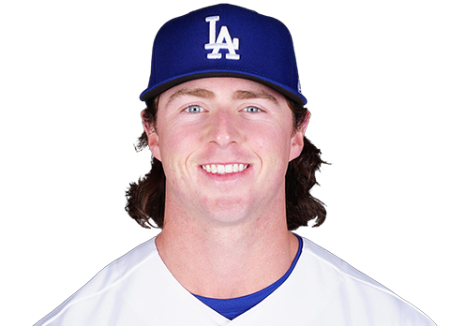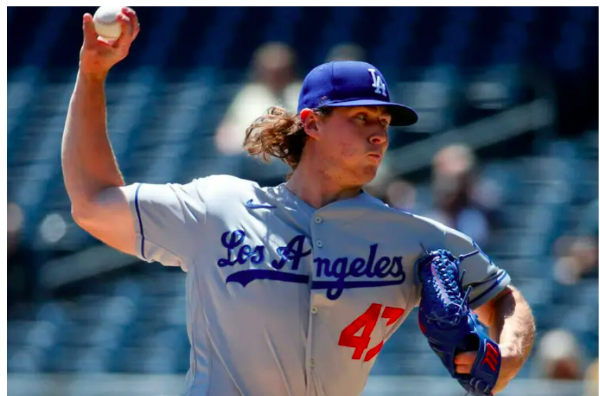
By STEVE KRAH
http://www.IndianaRBI.com
Ryan Pepiot has experienced quite a run in his life and career.
Since November 2021, Pepiot has gotten married, made his Major League Baseball debut and landed his first hole-in-one.
“I’ve had a pretty good 18 months,” says Pepiot, a right-handed pitcher with the Los Angeles Dodgers who began his third big league spring training camp at Camelback Ranch in Glendale, Ariz., Wednesday, Feb. 15.
The Indianapolis-born Pepiot was selected in the third round of the 2019 Major League Baseball First-Year Player Draft out Butler University (brother Kyle Pepiot is a senior outfielder for the Bulldogs in 2023; Ryan, a 2016 graduate of Westfield (Ind.) High School where he played for Ryan Bunnell, was recruited by Steve Farley and played at Butler for Dave Schrage) wed Lilia Poulsen in 2021.
Pepiot, 25, met the New Orleans native at Butler where she was studying ballet. Lilia — cousin of draft-eligible Ball State University right-hander Ty Johnson — was a ballerina was in a professional LA-based touring company prior to the COVID-19 pandemic.
“She’s going to get back into commercial dance when the season starts,” says Ryan of Lilia Pepiot.
The couple resides in Scottsdale, Ariz., where a favorite restaurant — Ocean 44 (a seafood and steak eatery) — is within walking distance.
“We like the oysters,” says Pepiot.
May 11, 2022 was Pepiot’s first MLB appearance. The afternoon game in Pittsburgh was attended by no less than 15 relatives and friends. Among them was his wife, brother, parents, in-laws, best friends from high school, college teammates and close family friends.
“It was the closet I played to home in a long time,” says Pepiot. “Indianapolis to Pittsburgh isn’t too far.
Pepiot, who once wore the uniform of the Chris Estep-led Indiana Mustangs travel team roster, made nine MLB mound appearances (seven starts) for the 2022 Dodgers and went 3-0 with a 3.47 earned run average. In 36 1/3 innings, he recorded 42 strikeouts and 27 walks. He also went 9-1 for the Triple-A Oklahoma City Dodgers.
“I learned a lot about myself — physically, mentally, everything,” says Pepiot of his time in the majors. “I learned that I can pitch and compete at the highest level.
“When I’m in the (strike) zone and attacking hitters I can give our team a chance to win ballgames. I learned how it all works being in that clubhouse with Hall of Famers and superstars. I got advice and picked their brains.”
In LA, Pepiot is in the starting rotation mix with left-hander Julio Urias, right-handers Dustin May and Tony Gonsolin, lefty Clayton Kershaw and righties Noah Syndergaard, Michael Grove, Andre Jackson and Walker Buehler.
“We’re in a good group so it will be interesting,” says Pepiot, who is still considered a rookie. “I’ll be happy whenever I can pitch and in whatever role I’m cool with it.”
Former big leaguer Mark Prior is the Dodgers pitching coach. He is assisted by Connor McGuiness.
Pepiot’s “out” pitch is his “circle” change-up.
He began developing the pitch — which runs away from left-handed batters and into righties — while playing for the Keene (N.H.) Swamp Bats in the summer of 2017.
“I needed something,” says Pepiot. “I’ve continued to fine-tune it ever since.”
Pepiot’s change-up — which is generally clocked at 84 or 85 mph or between 8 to 12 mph slower than his four-seam fastball — has been compared to that of Milwaukee righty closer Devin Williams.
While Williams throws his at around 3,000 RPM, Pepiot’s comes in around 2,500.
A slider is the other one of Pepiot’s three-pitch repertoire.
MLB rules call for a pitch clock in 2023. Pitchers will have 15 seconds to throw a pitch with the bases empty and 20 seconds with a runner on base. Hitters will need to be in the batter’s box with eight seconds on the pitch clock.
“It won’t be a big deal for me. I had it in Triple-A last year so I got used to it and I like to work fast,” says Pepiot. “The hard part is you might only have eight seconds to go through a sign sequence when the guy gets in the box.”
While there is no such system in the minors, MLB uses PitchCom to relay signals from catcher to pitcher. With the system, the catcher has a pad on his knee cap which is programmed with pitches and location. The pitcher has a receiver in his cap which tells him the desired pitch.
There is also the new pick-off rule. Pitchers will be allowed to disengage with the rubber twice per plate appearance. This number resets if a base runner advances within the same plate appearance.
A third step-off with result in a balk, unless at least one offensive player advance a base or an out is made on the ensuing play.
“That one’s a little difficult,” says Pepiot.
How about that hole-in-one?
Pepiot, who plays golf a couple of times a week, picked up the game after he was drafted. He was on the links often after COVID came along. Lilia’s parents live next to a country club near New Orleans.
His ace came in the Justin Turner Golf Classic Feb. 6 at Sherwood Country Club in Thousand Oaks, Calif. He was using a 9-iron in the 182-yard par-3 hole.



